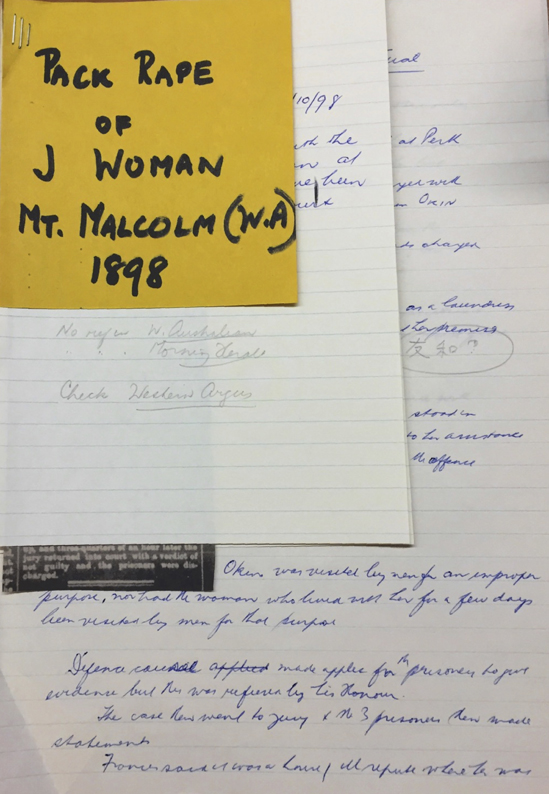I met Okin for the first time nestled amongst the original manuscripts of D.C.S. Sissons at the Special Collections reading room in the National Library of Australia (NLA). Okin was buried inside a folder entitled ‘Violent Crimes,’ inside a box full of folders dedicated to karayuki san.[1]

Karayuki, literally means going to China, and is the term commonly used for Japanese women, mostly from Kyushu, who worked overseas for subsistence. According to an article in the Tokyo daily newspaper Kokumin in early 1896, often the women were smuggled outside onboard steamers; usually went to Hong Kong first, where they were found by agents, and sold to brothels including those in Australia. At the time there were about 200 Japanese brothels, perhaps more according to further research by Sissons, operating in Australia. Most Japanese women living in Australia around this time were prostitutes, although various census results showed that they had listed their occupations as seamstresses, laundress, servants and alike. [2]
Around 3pm on the 29th of July, 1898, three men allegedly forced themselves into a house occupied by a Japanese man and several Japanese women in Mount Malcolm (Western Australia). The two of the younger men, William Gleeson and Charles Francis raped Okin in her bedroom whilst the older man, Charles Thomas Edwards, stood guard at the door. The Japanese manager Enaba went to the police for help. When Constable John Donovan arrived on the scene, Edwards was no longer there, but he heard a woman screaming, and he found Okin lying on the bed with Gleeson at the foot of the bed, and Francis standing at her head. Clothing of all three were in disarray. Donovan arrested the two men. The third man Edwards was arrested at a later date. [3]
Francis stated that two days prior to the alleged offence, he had visited Okin and was entertained by her. On the day in question, he visited again in company of his friends. His friends waited in the next room whilst he was with Okin. He called his friend Gleeson for a loan of a pound to offer to her. Gleeson entered the room to lend him the money, whilst Okin replied she had no change. Gleeson was “making overtures ” to her, when the police arrived and arrested them.

Okin’s rape case went to the Criminal Court in Western Australia on 7 October, 1898 before his Honour Justice James and a jury of 12. Francis and Gleeson were charged with “carnally knowing against her will,” and Edwards, for having aided and abetted Francis. The men pleaded not guilty. All women and youths under 18 years of age were ordered out of court.
The Crown Solicitor, R. B. Burnside detailed the case, and stressed the importance of protecting the chastity of women whatever her “colour and creed.” He added that even if she was “only a courtesan, and however low her character, if she did not consent she was entitled to the protection which the law gave to her in common with the most virtuous of women.”
Okin and Enaba gave statements through an interpreter. They both denied that the place they and several other women lived was a brothel, and that Okin had been working there as a laundress. Her hour long cross examination by the defence lawyer Vyner was mostly to elicit facts regarding her mode of living, which at times were delicate, and solicited laughter from the court as well as from the accused.
Justice James summed up the case, referring to the difficulty of obtaining evidence from Japanese witnesses through an interpreter; that there was no evidence that Okin was a prostitute, and on the contrary, the evidence given by Constable Donovan showed that the house where she lived was not known, as usually was, as a brothel; that he agreed with the Crown Solicitor that rape was rape regardless of the reputation of the woman; and that the charge was most serious: rape was a capital offence.
The jury could not agree in the first instance and the court adjourned. [AN ALLEGED CAPITAL OFFENCE. THREE MEN CHARGED. THE JURY UNABLE TO AGREE., 1898]
The jury eventually returned a not guilty verdict and then men were acquitted on 18 October, 1898.[4]
[1] Sissons, D. C. S. & Horwitz, Solis. 1950, Papers of D.C.S. Sissons, 1950-2006 [manuscript]
[2] Sissons, D.C.S. (1977) ‘Karayuki‐San: Japanese prostitutes in Australia, 1887–1916— I*’, Historical Studies, 17(68), pp. 323–341. doi: 10.1080/10314617708595555.
[3] AN ALLEGED CAPITAL OFFENCE. THREE MEN CHARGED. THE JURY UNABLE TO AGREE. (1898) The West Australian, 8 October, p. 7.
[4] THE MOUNT MALCOLM CASE. ACCUSED ACQUITTED (1898) The West Australian, 19 October, p. 7.

 Add to favorites
Add to favorites

Pretty! This has been an extremely wonderful post. Thanks for providing these details.|
I’m not that much of a internet reader to be honest but your blogs really nice, keep it up! I’ll go ahead and bookmark your site to come back later on. Many thanks|